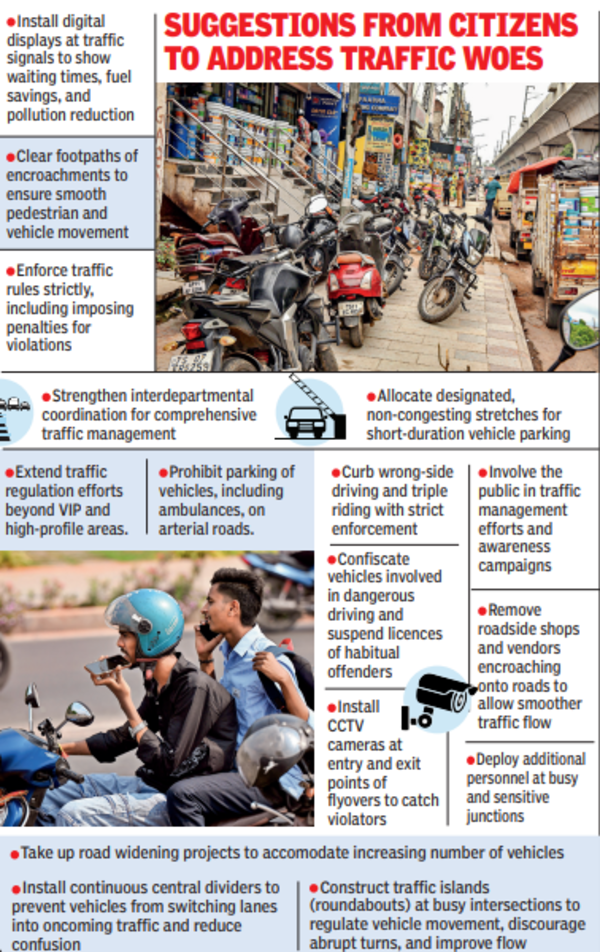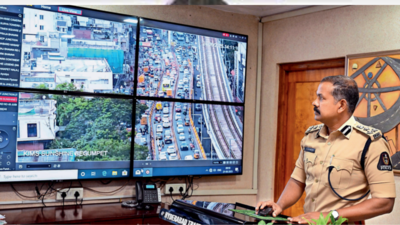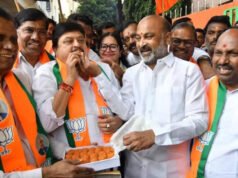Responding to queries from TOI readers, D Joel Davis , joint commissioner of police (traffic), Hyderabad, says the department is using drones and hi-tech cameras to monitor congested stretches and take corrective steps. He also said that the police is cracking a whip on underage and wrong-side drivingDespite a strong public transport system — buses, metro, and MMTS — why are traffic jams still rampant? What steps are police taking to improve flow? — Jahnavi VenkatHyderabad has vehicular traffic of about 90 lakhs (registered vehicles of GHMC limits), apart from vehicles coming from neighbouring districts and states. This is a 42% increase in the last five years. As a long-term strategy, we must think of solutions to improve and encourage people to travel in the public transport system and reduce the volume of private vehicles apart from other measures. Real-time incident identification and management are being done with the help of high-rise cameras and drone patrol. We are increasing the manpower deployment for traffic regulation. Congested corridors and bottlenecks are being identified through drone cameras, and details are being shared for engineering intervention. Weekly roadside markets are leading to massive traffic jams across the city. Why can’t these markets be shifted to nearby vacant grounds? — Srinivas AyyagariWe identified 105 such weekly markets in the city. We are identifying open lands in the neighbouring areas that will be convenient for the local public and will inform the GHMC authorities to relocate them. These locations include Film Nagar and Banjara Hills, among other places. However, we must ensure that these places are not far from colonies so that residents do not have to travel long distances to buy vegetables. Wherever it is possible to shift the markets, we are identifying convenient times and days so that there won’t be any traffic problems for commuters. Why do we still see one-way restrictions or blocked turns introduced during Metro construction, like the one on Road No. 36? Are there plans to revoke them? — Kamal Narayan RathiMost of these restrictions were brought in around 2019. Until 2022, it was not an issue as many people were working from home. But, lately, most companies resumed five-day work from the office. The vehicle flow has increased exponentially. The dynamics have changed. So, we cannot compare today’s traffic with the traffic from about five years ago. Wherever possible, we have reverted to the old style and reopened turns. In other places, we are conducting studies. In fact, a new simulation study is being carried out in and around KBR Park. We will be able to take a call after the study.

The Rasoolpura junction is narrow due to a statue railing, creating a bottleneck. Can it be relocated? Also, how many such obstructions exist across Hyderabad, and what is being done about them? — Sheelagh PatelIt is true that the railing diameter is obstructing the traffic flow and needs to be reduced. We will be taking up the issue with the civic authorities. Similarly, there are many religious places in the middle of the road. Some of them even pose a danger to commuters. However, more than the police, the commuters or locals should come forward and ensure that they are shifted, as this is a sensitive matter. They are the ones who are suffering the most as these structures are creating bottlenecks. In the same way, there are trees blocking carriageways, and we are translocating them by taking the required permissions.Closure of U-turns in several areas is forcing people to travel kilometres unnecessarily, wasting time and fuel. Is there any exercise to rationalise U-turn locations? — Asif MujawarSome of the U-turns are closed based on the current traffic patterns. Field studies are going on to identify new U-turn locations to reduce the distance. The main problem is these turns can be introduced only on wide roads where there are at least three lanes with good visibility on both sides, away from intersections with comfortable traffic volume. In many places, there are hardly any alternate places where these turns can be moved. However, the distance of a U-turn should not encourage people to drive in the wrong direction and risk their and fellow drivers’ lives. There will be zero tolerance against people driving in the wrong direction.Do police track accidents near U-turns? What measures are in place to improve safety at these spots? — Prasad NandulaIn the past six months, 69 accidents occurred in and around U-turns, mostly because of drivers’ behaviour. However, our system captures a distance of 500m radius from the accident spot, so we cannot exactly say if they happened right at the turn or not. To enhance safety, signboards, bollards, and reflective barricades are being installed to protect turning vehicles from oncoming traffic.What happened to Operation ROPE, and did it have any real impact? — CV RaghavuluOperation ROPE (Removal of Obstructive Parking and Encroachments) is an ongoing effort, and free left clearance is very much a part of it. Regarding free left blocking, we booked 31,038 cases during the last six months. In fact, we even filed cases against 40 repeat offenders. Further, we have decided to take the help of HYDRAA to get permanent encroachments removed from the road.Why are police not implementing lane driving in the city, which could help improve traffic discipline? — Rizwan MohamedTo implement lane discipline, the roads should be uniform and continuous without intersections or bylanes. Here, the problem is we have four lanes somewhere, and a little ahead, it will reduce to three or two. We are identifying stretches where lane driving can be implemented. On a pilot basis, we are making efforts to implement it in a stretch with an electronic enforcement facility, as physical implementation can be dangerous to traffic personnel. We are going to install signages, notify the public, and see if lane driving can be implemented.Are Hyderabad police leveraging technology for traffic management? – Sandeep KumarWe are making use of Pan-tilt-zoom (PTZ) cameras to monitor congested stretches. We have installed on high rises, such as BRK Bhavan, which will enable us to monitor 2.5 km to 3 km stretch using one camera. Otherwise, incident identification, be it vehicle breakdown, accident, or water logging, until someone dials 100 or our personnel on the ground at the next location get to know about it. Using PTZ, we are getting to know in seconds. We have installed these cameras in 20-25 congested stretches. We will be installing them in more locations. By using, drones and PTZ cameras we are going to monitor congested roads in the city and improve traffic flow.There is a severe shortage of parking space in the city. In such cases, where are we expected to park? — Cdr D Sarma (Retd)The existing rules and regulations related to establishments are not being implemented effectively over a period of time. Civic authorities have taken up multilevel parking at several places. Similar utilisation of public places for parking and integrating private available spaces to facilitate parking on a payment basis through an app may also help.Is it true that Hyderabad has only 3,500 traffic personnel for nearly 90 lakh vehicles? How are you managing this shortfall, and has a request been sent to recruit more staff? — Venkat RudraYes, it is true. We have only 3,100 traffic personnel, including Home Guards. In the recent recruitment, the Commissioner of Police, Hyderabad City, has given priority to the traffic wing and strengthened it. Recently, the govt permitted the utilisation of the services of transgenders as traffic assistants. HYDRA volunteers and Traffic Marshals, with the support of private organisations, are also being utilised for traffic regulation.If cities like Delhi and Gurgaon, once infamous for traffic violations, have managed to significantly improve road discipline, why is Hyderabad still struggling with basic traffic issues? — Mehernosh Bazun DittiaI agree with you. Discipline comes with effective enforcement. We should have the capability of capturing all the violations committed by leveraging technology, and we are working on it. 100% realisation of imposed challans has to be ensured through various measures. Citizen acceptance and participation are key to bringing discipline on the roads.What measures are police taking to address underage driving? – Keerthana MOn April 5, we launched a drive against underage driving. Since then, we have booked 4, 191 cases. Whenever a minor is caught in such cases, we file two cases—one against the minor in front of the juvenile board and the other in a regular court against the parent or guardian-the vehicle owner. While normally, juvenile is awarded social service, they can also be sent to a juvenile home, and the parent to jail. In as many as 2, 453 disposed cases, we have written to the transport department along with a disposal letter, seeking cancellation of the registration of the vehicle preventing it from being used on the road for one year. The juvenile, meanwhile, will not be able to get a license until the age of 25. To date, 782 vehicle registrations have been cancelled.Why are there no traffic cops, especially on Raj Bhavan Road during non-VIP times? Wrong-side driving is rampant and repeated complaints are ignored. — Ravi KantEven on normal days, one police constable or home guard is posted at Raj Bhavan, MMTS, and Metro residency to regulate traffic. We will increase the enforcement against wrong-side driving in this stretch. However, citizens should understand that we have 600 junctions in Hyderabad, and about 400 of them are only manned by police. To man a junction, we need at least two personnel, and it is not possible to put them in all places, including non-congested stretches. We will, however, concentrate on regulations and strictly initiate action against those indulging in wrong side driving and ensure that they are punished.Are any training programs being conducted for traffic police to improve active traffic management instead of just monitoring and issuing challans? — Kasi TInduction training and refresher courses are being conducted periodically to enhance the skills of our subordinates. Even today, 40 volunteers are trained through our training center. Whenever someone gets transferred, they are made to undergo sixday training on various modules. This training also includes behavioural aspects as those posted on the ground are also taught how to interact and deal with the public.Why aren’t traffic police using the city’s CCTV network more effectively to issue challans to violators? — Vinod RaoThe city is extensively covered with CCTVs. However, not all CCTVs are being used and cannot be to issue challans. We need ANPR (Automated Number Plate Reading) cameras to issue challans and Wherever they are available, we are issuing challans electronically. In other cameras, number plate reading, especially that of a moving vehicle, is a challenge. We are working out with the startup companies to use the normal camera feed for challan generation. We have asked them to come up with a solution and soon after, we are going to use our CCTV network fully to issue challans.Wrong-side driving is a major issue across the city. What are the penalties for this and are stricter punishments being considered? — Anurag KalraAs per the Motor Vehicle Act 1988, a fine of up to Rs 1100 can be imposed. We have identified various hotspots where wrong-side driving is prevalent. It is mostly repeated users who indulge in this violation as they are aware that there is a U-turn in hardly 500 meter distance. Shortly, we will install cameras at hotspots and start electronic enforcement to generate challans.High-beam headlights within city limits are a menace and dangerous for oncoming traffic. Are challans issued for this and are people being educated about the risks? — TSS PrasadFor this violation, enforcement is really a challenge. It is hard to prove or capture when someone is using a high beam. Even if we submit photographic evidence, we won’t be able to convince the court and offender. Physically also is difficult to catch these offenders. We feel the transport department should educate drivers while issuing licence. Our training teams are also conducting awareness programmes in schools, colleges, and office spaces on this subject.Why can’t traffic violators be made to assist in regulating traffic for an hour instead of just paying fines? Are any alternative punishment models being explored? — S R DhravidCourts are empowered to award social service as punishment and they are awarding it in many cases, in minor driving violations, etc. The police cannot make this decision and force violators to assist them in handling traffic.What happened to the coordination committees that used to inspect bottlenecks and ensure the timely removal of obstacles like poles and encroachments? Can they be revived? — Kanchiraju KasinathThe system is continued even now and frequent convergence meetings are being conducted with all stakeholders. The traffic police on their part collect details about various issues, waterlogging, the need for road expansion, trees causing jams, etc, and raise them in these meetings. In fact, we could get 50% of the waterlogging points resolved from last year through these meetings. Similarly, when I was with Cyberabad, we got various roads such as the one from Cyber Towers to Yashoda Hospitals, Ikea to Cyber Towers, among others, expanded to accommodate growing traffic. We are using drone visuals taken during peak traffic to build our case and get various issues resolved.How does Hyderabad Traffic Police plan to deal with those road users who are willing to break traffic signals and jeopardize the safety of law-abiding road users? —S. VenkatanarayananStop line violations and Signal breaking are life-endangering violations. Hyderabad Traffic Police has booked 79, 055 cases in the year 2025 (as on June 19). We intend to use AI for life-endangering violations with less human intervention to improve road safety in the city.








